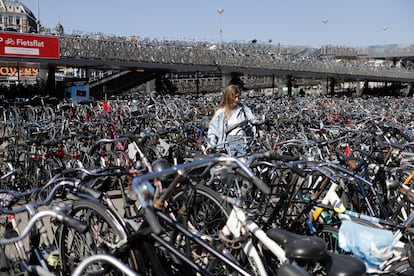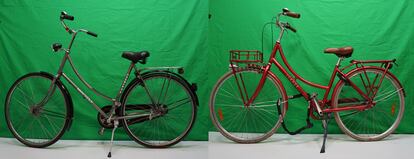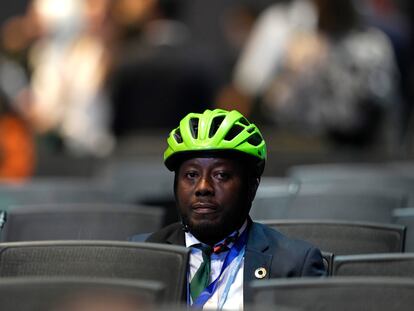‘We didn’t know if they were being taken to another country:’ Where do stolen Dutch bikes go?
GPS tracking of a hundred stolen bikes in Amsterdam shows they are back in circulation in the same city

The Netherlands, and particularly Amsterdam, are global models for how to make cycling the basis of a healthy and sustainable transportation system. But about half a million of them are stolen every year. It might seem that stealing such a large number of bicycles in a country of just 17 million inhabitants would compromise the whole transportation scheme. However, an original investigation that has followed a hundred bikes equipped with GPS shows that the thieves do not take them very far. In fact, within a few days the bicycles are back in use as a means of transportation around the city, albeit ridden by someone else.
Researchers at the Massachusetts Institute of Technology (MIT) and the Delft University of Technology in the Netherlands set out to find out where so many stolen bicycles go. In Amsterdam alone, between 28,500 (according to the municipality) and 80,000 (estimated by cycling associations) are stolen. In fact, bicycle theft is so common that many people do not even report it, so the figure might be closer to the latter than the former. Fábio Duarte, the principal investigator at MIT’s Senseable City Lab, which studies technology in cities to apply it to urban design, says that they started with an assumption. As with vehicles and other stolen goods, “we thought they were being taken abroad, perhaps to countries in the East,” he says. But it turns out the bicycles were much closer to home.
The investigation, which was conducted in collaboration with the Amsterdam city council, found that many of the stolen bicycles remained in the Dutch capital. The study distributed a hundred of them in areas with a high concentration of bicycles, such as squares or near rail and bus stations. The bikes were all locked and researchers ensured that the bicycles’ appearance and condition did not stand out from others: all 100 were secondhand, but the investigation used a dozen brands in all conditions, from rusty to practically new. The bicycles had a GPS tracking device hidden in the light or under the saddle and were tracked between June and December 2021. The result, published in the scientific journal PLoS ONE, was that thieves took 70 of them.
Criminal organizations steal them, but they sell them to other Amsterdam residents. It is even possible that someone is buying a bike that was stolen from them some time ago”Fábio Duarte, the principal researcher at MIT's Senseable City Lab
“Where you leave your bike is key,” says Duarte. “The more there are, the more likely it is to be stolen.” Researchers believe that bike thieves take advantage of areas where there are a lot of bikes so that their theft goes unnoticed. “If there are only a few [bicycles], there is always the chance that the owner is nearby,” says Duarte. Other data from the study are relatively obvious: thefts are more common near stations and other high-traffic areas and the vast majority of bikes are stolen at night.
GPS tracking allowed the researchers and the Amsterdam authorities to determine where the bikes went after they were stolen. It turns out that only two of the 70 stolen bikes were taken outside of Amsterdam or its surroundings, and none left the country. Tracking showed that after a few days without moving or with random movements, the bikes followed a pattern of two trips a day with the same round trip each time. That is to say: another Amsterdam resident was using it to get to work and back home.
“We thought criminal organizations were stealing them, but we didn’t know if they were taking them to another country,” says Duarte. Based on network analysis of the data, researchers deduced that at least a third of the bicycles had been stolen by a criminal organization. “What happens is that criminal organizations steal them, but they sell them to [other] people in Amsterdam. It’s even possible that someone might be buying a bike that was stolen from them some time ago.”

Half a century ago, Amsterdam pioneered an experiment that sought to universalize the use of bicycles in a city that was drowning in traffic. To address the issue, the city launched the white bicycle project and distributed a fleet of 10,000 bikes throughout the city, which anyone could use. It was the first shared transportation system, decades before the idea was discussed. But the experiment failed, falling into the so-called tragedy of the commons: since the bicycles belonged to everyone, they didn’t belong to anyone; many ended up smashed, while others were taken home by thieves who painted them a different color. Paradoxically, now thieves value the bicycles and protect them from falling victim to the tragedy of the commons.
Titus Venverloo, a researcher at Delft University and MIT and the study’s co-author, says that analysis of the movement of stolen bikes shows “that they return to a regular pattern of mobility quite quickly.” That implies that most are either used directly or sold quickly, “so these bikes become available again for general transportation in the city,” he adds. Venverloo also highlights a certain positive aspect of the theft: “The wide availability of cheap bicycles of dubious origins also seems to encourage cycling in the city, as that mode of transportation is highly accessible to anyone.” The researcher also notes a third aspect of the phenomenon: “In addition, due to the strong cycling culture in the Netherlands, residents of Amsterdam are practically accustomed to the problem of bicycle theft. Therefore, they can buy another bike quickly.” Thus, Venverloo concludes that “bicycle theft doesn’t have a major effect on the city’s transportation system, although the effect on the victim of bicycle theft is obvious.”
These results are tied to the approach of certain anarchist groups in the Netherlands who, in the 1980s, promoted bicycle theft”Pedro Malpica, a sociologist who specializes in sustainable transportation
Pedro Malpica, a sociologist and expert in sustainable mobility, comments that “these results connect with the approaches of certain anarchist groups in the Netherlands who, in the 1980s, promoted bicycle theft. That wasn’t so much because of their disdain for private property, but rather because they were convinced that it was a viable means of shared transportation.” But Malpica, who wrote his thesis on cycling transportation in transitioning to a new urban model in Spain, also notes that theft can have a negative effect: the person “who starts riding a bicycle that is then stolen doesn’t continue to use it.” Fortunately, he adds, his fieldwork showed that public bike systems alleviate this problem. “They don’t want to buy a second bicycle after the first theft, but they don’t abandon urban cycling.” Both Malpica and Duarte believe that if the police were to prioritize the prosecution of criminal organizations, it would encourage the use of bicycles as urban transportation.
Sign up for our weekly newsletter to get more English-language news coverage from EL PAÍS USA Edition
Tu suscripción se está usando en otro dispositivo
¿Quieres añadir otro usuario a tu suscripción?
Si continúas leyendo en este dispositivo, no se podrá leer en el otro.
FlechaTu suscripción se está usando en otro dispositivo y solo puedes acceder a EL PAÍS desde un dispositivo a la vez.
Si quieres compartir tu cuenta, cambia tu suscripción a la modalidad Premium, así podrás añadir otro usuario. Cada uno accederá con su propia cuenta de email, lo que os permitirá personalizar vuestra experiencia en EL PAÍS.
¿Tienes una suscripción de empresa? Accede aquí para contratar más cuentas.
En el caso de no saber quién está usando tu cuenta, te recomendamos cambiar tu contraseña aquí.
Si decides continuar compartiendo tu cuenta, este mensaje se mostrará en tu dispositivo y en el de la otra persona que está usando tu cuenta de forma indefinida, afectando a tu experiencia de lectura. Puedes consultar aquí los términos y condiciones de la suscripción digital.
More information
Archived In
Últimas noticias
Chris Martin, Taylor Swift, Elijah Wood and other famous wedding ‘crashers’
‘How does it feel to be a failure?’: Elizabeth Berkley’s journey from ‘Showgirls’ ridicule to vindication
The story of the Málaga virus: The code that haunted Google’s cybersecurity center director for 30 years
The impact of Ecuador’s mega-prison: A polluted river, cleared forests and military checkpoints
Most viewed
- Christian Louboutin: ‘Young people don’t want to be like their parents. And if their parents wear sneakers, they’re going to look for something else’
- The low-cost creative revolution: How technology is making art accessible to everyone
- Liset Menéndez de la Prida, neuroscientist: ‘It’s not normal to constantly seek pleasure; it’s important to be bored, to be calm’
- All the effects of gentrification in one corner of Mexico’s Colonia Roma
- December Social Security and SSI payments: Dates, double checks and the 2026 COLA increase











































